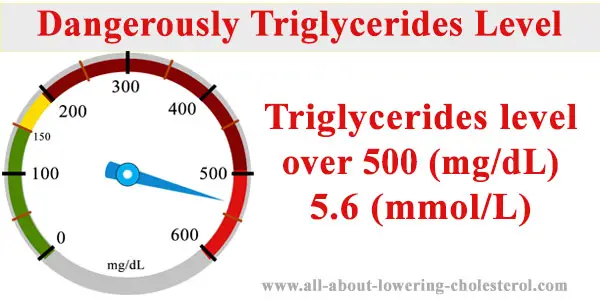
Triglyceride levels higher than 500 mg/dl are considered very high levels. This condition may be due to numerous causes, such as obesity, eating more calories than burning, drinking too much alcohol, and kidney disease, heredity, genetics, poorly controlled diabetes, hypothyroidism.
Very high triglyceride levels are associated with an increased risk of developing numerous health issues, such as cardiovascular disease, strokes, peripheral arterial disease, strokes, metabolic syndrome, and acute pancreatitis.
What does having a triglyceride level higher than 500 mg/dl mean?
Triglycerides are a type of fat found in the blood. When we eat, our body converts the calories it does not use into triglycerides, so, in other words, they store the excess energy, to use later when the body needs it.
Triglycerides are not the same as cholesterol. It is important to highlight this detail because a lot of people mistake one for another.
They are both lipids, but triglycerides are fat, stored fat, and excess fat that the body has no need for the moment, whereas cholesterol is a type of lipid used to build some important hormones and cell walls.
A certain level of triglycerides are needed for the normal functioning of the body, but triglyceride level higher than 500 mg/dl is considered very high and are associated with a very increased risk of developing cardiovascular problems and numerous other problems.
Triglyceride levels higher than 500 mg/dl – What are the levels of risk for cardiovascular disease?
Triglyceride levels higher than 500 mg/dl are associated with a high risk of developing cardiovascular disease.
Although it is yet unclear how, triglycerides may contribute to developing plaques in the walls of the coronary arteries, and also can contribute to the hardening and thickening of the arterial wall.
This process narrows the inner space of the arteries, causing the blood flow to diminish. Less blood flow means less oxygen, and less oxygen leads to the suffering of the cardiac tissue, causing numerous clinical presentations, and can even result in sudden death.
Is triglyceride level higher than 500 mg/dl – What about the risk for any other health problems?
Triglyceride levels higher than 500 mg/dl are associated with a high risk of developing other health issues, apart from other cardiovascular problems, as well.
1. It can cause hardening and thickening of the peripheral arterial walls (the upper and lower limbs) as well, causing bad perfusion of the tissues distal to the obstruction.
2. Strokes- when the aforementioned process happens in the walls of cerebral arteries and causes a significant obstruction with a significant diminishment of the blood flow, the stroke happens.
3. Metabolic syndrome- it is a combination of high blood pressure, high blood sugar, too much fat around the waist, low LDL cholesterol, abnormal cholesterol levels, and high triglycerides. Metabolic syndrome itself increases the risk of cardiovascular disease, diabetes, and stroke.
4. Extremely high triglycerides, usually above 1000 mg/dl, can cause acute pancreatitis.
Causes of Triglyceride level higher than 500 mg/dl?
Triglyceride levels higher than 500 mg/dl can be caused by numerous conditions. The following are the most important conditions:
1. Obesity
2. Poorly controlled diabetes
3. Hypothyroidism
4. Kidney disease
5. Eating more calories than you burn, regularly
6. Drinking a lot of alcohol
7. Drugs such as steroids, beta-blockers, diuretics, tamoxifen, estrogen, birth control pills
8. Heredity- in some cases high levels of triglycerides can run in the family.
